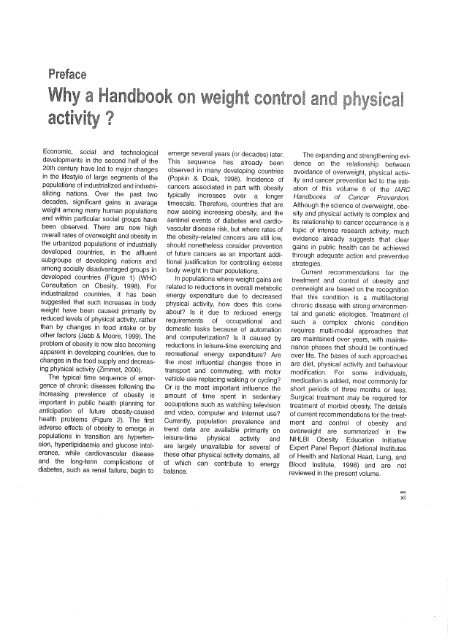IARC Handbooks of Cancer Prevention
IARC Handbooks of Cancer Prevention
IARC Handbooks of Cancer Prevention
Create successful ePaper yourself
Turn your PDF publications into a flip-book with our unique Google optimized e-Paper software.
Preface<br />
hy a Handbook on weight control and physical<br />
activity ?<br />
Economic, social and technological<br />
developments in the second half <strong>of</strong> the<br />
20th century have led to major changes<br />
in the lifestyle <strong>of</strong> large segments <strong>of</strong> the<br />
populations <strong>of</strong> industrialized and industrializing<br />
nations. Over the past two<br />
decades, significant gains in average<br />
weight among many human populations<br />
and within particular social groups have<br />
been observed. There are now high<br />
overall rates <strong>of</strong> overweight and obesity in<br />
the urbanized populations <strong>of</strong> industrially<br />
developed countries, in the affuent<br />
subgroups <strong>of</strong> developing nations and<br />
among socially disadvantaged groups in<br />
developed countries (Figure 1) (WHO<br />
Consultation on Obesity, 1998). For<br />
industrialized countries, it has been<br />
suggested that such increases in body<br />
weight have been caused primarily by<br />
reduced levels <strong>of</strong> physical activity, rather<br />
than by changes in food intake or by<br />
other factors (Jebb & Moore, 1999). The<br />
problem <strong>of</strong> obesity is now also becoming<br />
apparent in developing countries, due to<br />
changes in the food supply and decreasing<br />
physical activity (Zimmet, 2000).<br />
The typical time sequence <strong>of</strong> emergence<br />
<strong>of</strong> chronic diseases following the<br />
increasing prevalence <strong>of</strong> obesity is<br />
important in public health planning for<br />
anticipation <strong>of</strong> future obesity-caused<br />
health problems (Figure 2). The first<br />
adverse effects <strong>of</strong> obesity ta emerge in<br />
populations in transition are hypertension,<br />
hyperlipidaemia and glucose Intolerance,<br />
while cardiovascular disease<br />
and the long-term complications <strong>of</strong><br />
diabetes, such as renal failure, begin to<br />
emerge several years (or decades) later.<br />
This sequence has already been<br />
observed in many developing countries<br />
(Popkin & Doak, 1998). Incidence <strong>of</strong><br />
cancers associated in part with obesity<br />
typically increases over a longer<br />
timescale. Therefore, countries that are<br />
now seeing increasing obesity, and the<br />
sentinel events <strong>of</strong> diabetes and cardiovascular<br />
disease risk, but where rates <strong>of</strong><br />
the obesity-related cancers are still low,<br />
should nonetheless consider prevention<br />
<strong>of</strong> future cancers as an important additional<br />
justification for controllng excess<br />
body weight in their populations.<br />
ln populations where weight gains are<br />
related to reductions in ove rail metabolic<br />
energy expenditure due to decreased<br />
physical activity, how does this come<br />
about? is it due ta reduced energy<br />
requirements <strong>of</strong> occupational and<br />
domestic tasks because <strong>of</strong> automation<br />
and computerization? is it caused by<br />
reductions in leisure-time exercising and<br />
recreational energy expenditure? Are<br />
the most influential changes those in<br />
transport and commuting, with motor<br />
vehicle use replacing walking or cycling?<br />
Or is the most important influence the<br />
amount <strong>of</strong> time spent in sedentary<br />
occupations such as watching television<br />
and video, computer and Internet use?<br />
Currently, population prevalence and<br />
trend data are available primarily on<br />
leisure-time physical activity and<br />
are largely unavailable for several <strong>of</strong><br />
these other physical activity domains, ail<br />
<strong>of</strong> which can contribute to energy<br />
balance.<br />
The expanding and strengthening evidence<br />
on the relationship between<br />
avoidance <strong>of</strong> overweight, physical activity<br />
and cancer prevention led to the initiation<br />
<strong>of</strong> this volume 6 <strong>of</strong> the <strong>IARC</strong><br />
<strong>Handbooks</strong> <strong>of</strong> <strong>Cancer</strong> <strong>Prevention</strong>.<br />
Although the science <strong>of</strong> overweight, obesity<br />
and physical activity is complex and<br />
its relationship to cancer occurrence is a<br />
topic <strong>of</strong> intense research activity, much<br />
evidence already suggests that clear<br />
gains in public health can be achieved<br />
through adequate action and preventive<br />
strategies.<br />
Current recommendations for the<br />
treatment and control <strong>of</strong> obesity and<br />
overweight are based on the recognition<br />
that this condition is a multifactorial<br />
chronic disease with strong environ<br />
mental<br />
and genetic etiologies. Treatment <strong>of</strong><br />
such a complex chronic condition<br />
requires multi-modal approaches that<br />
are maintained over years, with maintenance<br />
phases that should be continued<br />
over life. The bases <strong>of</strong> such approaches<br />
are diet, physical activity and behaviour<br />
modification. For some individuals,<br />
medication is added, most commonly for<br />
short periods <strong>of</strong> three months or less.<br />
Surgical treatment may be required for<br />
treatment <strong>of</strong> morbid obesity. The details<br />
<strong>of</strong> current recommendations for the treatment<br />
and control <strong>of</strong> obesity and<br />
overweight are summarized in the<br />
NHLBI Obesity Education Initiative<br />
Expert Panel Report (National Institutes<br />
<strong>of</strong> Health and National Heart, Lung, and<br />
Blood Institute, 1998) and are not<br />
reviewed in the present volume.<br />
xi

















